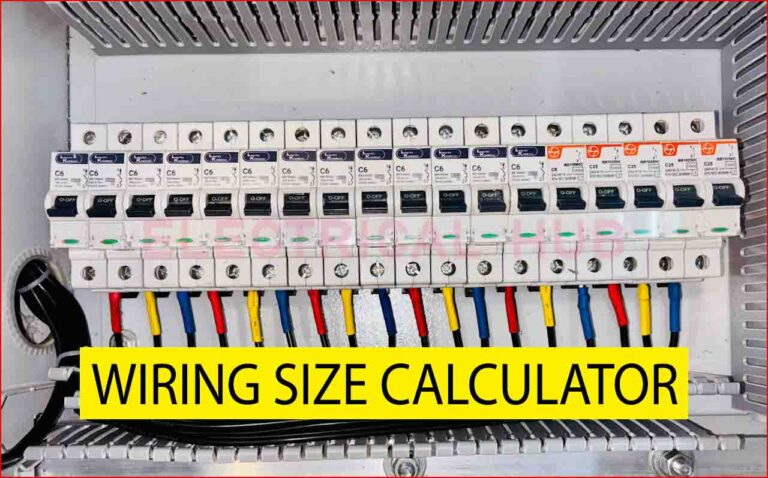Transformer Neutral Current Calculator – Accurate Neutral Current Estimation
A transformer neutral current calculator is an essential tool for electrical engineers, facility managers, and anyone working with three-phase power systems. It helps determine the current flowing through the neutral conductor of a transformer under unbalanced loading or harmonic conditions. Neutral current is often overlooked, but it has a major impact on power quality, transformer efficiency, and overall system reliability. Understanding how to calculate this current is key to safe and stable electrical design.

Table of Contents
This article explains how a transformer neutral current calculator works, why neutral current increases, and how engineers apply it in real installations. It also includes supporting tables and examples to improve clarity.
What Is Neutral Current in a Transformer
In a balanced three-phase transformer, current in all phases is equal and separated by 120 degrees. When that happens, the phase currents cancel out, and the neutral current becomes zero. In real installations, perfect balance rarely exists. Loads vary from phase to phase, and non-linear equipment creates harmonics. These conditions cause current to flow through the neutral point.
A transformer neutral current calculator estimates the magnitude of this current based on phase currents, system voltage, load imbalance, and harmonic content. Using such a calculator helps prevent overheating, conductor damage, and tripping issues in sensitive networks.
Transformer Neutral Current Calculator
Transformer Neutral Current Calculator
Estimate neutral current in a three-phase transformer system based on unbalanced phase loads. Supports Wye (Star) configurations.
How to Use: Enter the current draw for each phase, system voltage, and power factor. Select system type. The calculator will estimate neutral current using vector summation and show imbalance percentage.
Why Neutral Current Matters
Neutral current is more than a simple byproduct of imbalance. It affects the entire electrical system. High neutral current can lead to:
- Transformer overheating
- Nuisance breaker trips
- Voltage distortion
- Neutral conductor failure
- Increased energy losses
Non-linear loads such as UPS systems, LED lighting, computers, and variable-frequency drives generate third-harmonic currents. These harmonic components add together in the neutral and cause values much higher than expected. In some buildings, neutral current surpasses the phase current during peak load hours. A neutral current calculator helps predict these conditions before faults occur.
Know more about IEC Standards for Transformer Testing – Complete Guide to IEC 60076 and Testing Procedures
How a Transformer Neutral Current Calculator Works
Most calculators use the vector sum of the three phase currents. This is because neutral current is not a simple arithmetic difference; it depends on both magnitude and phase angle.
For non-harmonic loads, the basic formula is:
Neutral Current = √(I₁² + I₂² + I₃² − I₁I₂ − I₂I₃ − I₃I₁)
Where:
I₁ = Phase A current
I₂ = Phase B current
I₃ = Phase C current
A transformer neutral current calculator applies this formula and includes harmonic estimation when required.
Example Calculation
Assume a transformer has the following phase currents:
| Phase | Current (A) |
|---|---|
| A | 100 |
| B | 80 |
| C | 60 |
Plugging these values into the equation gives an approximate neutral current of:
Neutral Current ≈ 48 A
This means the neutral conductor must be sized for at least this much current. Using a calculator simplifies this process and reduces risk.
Impact of Harmonics on Neutral Current
In modern electrical networks, harmonic currents play a major role. Third-harmonic currents (150 Hz in a 50-Hz system) from each phase add up in the neutral. They do not cancel out like fundamental frequencies.
Use our online tool Conduit Fill Calculator for Multi Conductor Cable: Accurate NEC-Based Cable Sizing Tool
A transformer neutral current calculator that includes harmonic factors will show that even a lightly unbalanced system may have a high neutral current due to harmonics.
Common Sources of Third Harmonics
| Equipment Type | Harmonic Impact |
|---|---|
| LED lighting | High |
| Computer loads | High |
| Servers and data centers | Very High |
| UPS systems | Moderate to High |
| Office equipment | Moderate |
These loads distort current waveforms and create neutral overloading. Engineers use calculators to estimate both the fundamental and harmonic components to ensure safe transformer operation.
Importance of Accurate Neutral Current Calculation
Accurate neutral current estimation supports correct transformer sizing and conductor selection. Overloading the neutral conductor can lead to overheating and insulation damage. In sites with heavy electronic loads, the neutral conductor often requires a larger size than the phase conductors.
This is especially important in:
- Commercial buildings
- Hospitals
- Data centers
- Manufacturing plants
- Telecommunication facilities
A transformer neutral current calculator gives a clear picture of expected conditions, allowing engineers to design with proper safety margins.
Use our online tool Electricity Load Calculator in kVA – Accurate Power Load Estimation for Homes & Industries
Inputs Required in a Neutral Current Calculator
Most calculators require the following inputs:
- Line currents of each phase
- System voltage
- Power factor or phase angle
- Harmonic percentage (if applicable)
- Transformer connection type (Delta or Wye)
Wye-connected systems typically experience neutral current, while delta systems do not have a neutral point. However, delta windings may still experience circulating harmonic currents. A calculator designed for transformer monitoring takes this into account.
Neutral Current in Different Transformer Connections
Wye (Star) Connection
A Wye transformer with a neutral conductor is the most common configuration in distribution networks. Phase imbalance directly creates neutral current in this design.
Delta Connection
Delta transformers do not have an external neutral conductor, but harmonic currents circulate within the delta winding. This affects heating and efficiency even though no neutral conductor is present. Calculators for delta systems estimate internal winding currents instead of external neutral currents.
Wye-Delta or Delta-Wye
These configurations require careful harmonic analysis. A neutral current calculator can estimate how load imbalance on one side transfers to the other.
Table: Neutral Current Impact by Load Imbalance
| Load Imbalance Level | Typical Neutral Current | System Risk Level |
|---|---|---|
| Balanced (0–5%) | Near zero | Low |
| Mild (5–15%) | Low to moderate | Moderate |
| Medium (15–25%) | Moderate to high | High |
| Severe (>25%) | High | Very High |
Understanding these levels helps determine whether corrective measures are needed.
Use our online tool MM to AWG Wire Size Calculator According to IEC and NEC
Using a Transformer Neutral Current Calculator in Practice
Professionals use these calculators during system design, commissioning, troubleshooting, and routine assessments.
Design Stage
Engineers estimate future neutral load based on anticipated equipment. This ensures the transformer, cables, and protective devices are sized correctly.
Commissioning Stage
During installation, real current measurements are entered into the calculator. This validates the design and detects early imbalance.
Maintenance Stage
When equipment is added or removed, the calculator helps reassess the neutral loading.
Troubleshooting Stage
If a neutral conductor shows overheating or discoloration, the calculator helps identify whether imbalance or harmonics are the cause.
How to Reduce Neutral Current
While a transformer neutral current calculator helps you understand the issue, several solutions reduce neutral loading:
- Balancing loads across phases
- Using K-rated transformers
- Installing harmonic filters
- Increasing neutral conductor size
- Using power factor correction systems
- Applying three-phase equipment wherever possible
Each mitigation strategy depends on the site conditions.
Benefits of Using a Transformer Neutral Current Calculator
Using a calculator ensures:
- Improved transformer reliability
- Lower operating temperatures
- Reduced risk of conductor failure
- Better power quality
- Longer equipment life
- Compliance with electrical standards
For facilities with sensitive loads, calculating neutral current is not optional; it is part of good engineering practice.
Use our online tool Busbar Size Calculator – Accurate Sizing According to IEC and NEC Standards
Conclusion
A Transformer Neutral Current Calculator is a vital tool for analyzing load imbalance and harmonic impact in modern electrical systems. As non-linear loads continue to grow, neutral currents will remain a critical point of inspection. Understanding how to interpret and use a neutral current calculator helps ensure safe transformer operation, stable voltage levels, and long equipment life. Whether you are designing a new installation or assessing an existing one, accurately calculating neutral current is a fundamental step toward reliable electrical performance.
Follow Us on Social:
Subscribe our Newsletter on Electrical Insights for latest updates from Electrical Engineering Hub
#TransformerNeutralCurrentCalculator, #TransformerNeutralCurrent, #TransformerDesign, #ElectricalEngineeringTools, #PowerTransformer, #NeutralCurrentCalculation, #ElectricalSafety, #DistributionTransformer, #EngineeringCalculator, #PowerSystems






